Top automation industry trends that original equipment manufacturers need to know
The global warehouse automation market has seen steady growth the past 10 years, but recent global events have catapulted the industry into a mode of hyper-growth. With so many new opportunities on the horizon, there are areas you need to take into consideration in the coming year. To help warehouse automation technology vendors like you prepare better to support increased growth, we've compiled a list of key trends the industry is likely to face in 2022:
- Labor shortages leading to big growth opportunities in the warehouse automation market
- Supply chain issues regulating growth
- More robots and a greater mix of warehouse automation technologies
- Doing more in smaller spaces
- Longevity of warehouse robots
- A greater need for the Internet of Things (IoT)
- The beginning of mergers and acquisitions in the warehouse automation market
All of these warehouse automation trends have the potential to make major waves, so let’s dig in – the first two trends we foresee are continuations from previous years: labor shortages and supply chain issues.
Trend 1: Labor shortages leading to big growth opportunities in the warehouse automation market
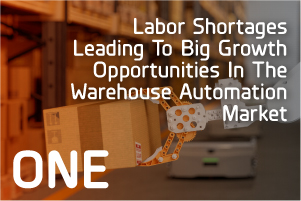 One major factor that has contributed to warehouse automation adoption is labor shortages, and they're projected to continue in this sector for the foreseeable future. With so many job openings, distribution centers and warehouses alike are being forced look at automation options in order to fulfill orders. While making large investments in warehouse automation solutions has been a big hurdle to overcome, now more than ever, they offer greater return on investment than human workers.
One major factor that has contributed to warehouse automation adoption is labor shortages, and they're projected to continue in this sector for the foreseeable future. With so many job openings, distribution centers and warehouses alike are being forced look at automation options in order to fulfill orders. While making large investments in warehouse automation solutions has been a big hurdle to overcome, now more than ever, they offer greater return on investment than human workers.
This greater return puts your market in prime position to grow dramatically over the coming years. In order to achieve that growth, you must be able to properly scale your output to meet your customers’ demands. Scalability presents its own challenges, but support is available through outsourcing opportunities with companies that specialize in these highly mechanical products.
Trend 2: Supply chain issues regulating growth
 We hoped this would be a trend of the past, but it is likely to continue. The good news is we do expect to see continued improvement in challenging supply chain conditions over time. With so much potential for growth in the warehouse automation sector, this one issue continues to be the primary hindrance to capitalizing on opportunities and the great equalizer for all providers.
We hoped this would be a trend of the past, but it is likely to continue. The good news is we do expect to see continued improvement in challenging supply chain conditions over time. With so much potential for growth in the warehouse automation sector, this one issue continues to be the primary hindrance to capitalizing on opportunities and the great equalizer for all providers.
The semiconductor and steel industries are still leading the charge with huge backlogs, but realistically getting all raw materials will continue to be an issue going forward. With global supply chains still in crisis, a way to mitigate the issue is to choose partnerships with companies that have well-established supply chain services as part of their offering. This key differentiator won't be a magic wand, but it will give companies insights to mitigate risks and the opportunity to develop strong relationships with multiple vendors that can be leveraged during the production process.
Trend 3: More robots and a greater mix of warehouse automation technologies
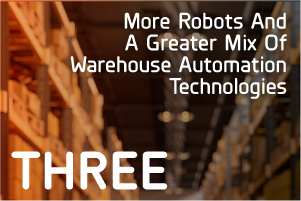 With the increase in opportunities, a variety of technologies have been developed to complete customer projects, including:
With the increase in opportunities, a variety of technologies have been developed to complete customer projects, including:
- Autonomous mobile robots (AMR)
- Automated guided vehicles (AGV)
- Collaborative robots or cobots
- Warehouse drones
- Conveyor systems
- And more
Each option is best suited to specific needs, but with more and more of your customers including "speed to fulfillment" requirements in their contracts, the variety of mobile robots and systems in a single facility is likely to increase. There are two options to make sure you're providing the best output for your customers:
- Creating your own complete automation solutions that includes a variety of robotics solutions
- Buying other solutions off-the-shelf and integrating them into your system
While both options have their benefits, they also present hurdles to overcome.
When building your own complete solutions with a variety of robotics technologies, you ensure that your system is designed to work seamlessly from start to finish. This offering is particularly attractive to your customers because it lessens the concern of incompatibility issues. But it can be difficult to provide if your company specializes in one type of automation technology over another. If you'd like to build a solution completely owned by your company, partnering with an outside firm that provides design and development services is a great option. With this industry being relatively new, it's important to make sure you look for a well-established company that has experience and expertise in this area.
Off-the-shelf options give you the ability to leverage the specialization of other companies so you don't have to split focus and design additional elements for your system. When going this route, integration into an already established system can be more difficult and with supply chains as they are, product availability can be an issue.
Trend 4: Doing more in smaller spaces
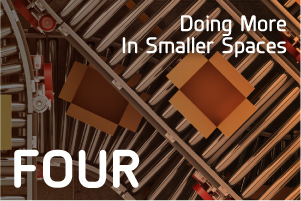 Even though warehouses are being built at record rates, the space in them is being leased out before construction is completed. That means that your customers are paying premiums to get as much space as they can. Add in other factors including environmental impacts, you’re being tasked, now more than ever, to give your customers more dollars per square foot in their warehouses. Tighter quarters mean the technologies deployed need to have an incredibly thoughtful initial design. And, when things get smaller, it often means they get more complex, which isn't something that every provider is equipped to handle.
Even though warehouses are being built at record rates, the space in them is being leased out before construction is completed. That means that your customers are paying premiums to get as much space as they can. Add in other factors including environmental impacts, you’re being tasked, now more than ever, to give your customers more dollars per square foot in their warehouses. Tighter quarters mean the technologies deployed need to have an incredibly thoughtful initial design. And, when things get smaller, it often means they get more complex, which isn't something that every provider is equipped to handle.
Making the choice early on to dig into design options that prepare your solutions for working in a smaller square footage is a great way to get ahead of the competition. If in-house expertise isn't available to devote time to this trend, then outside resources are available. The best resources are ones that not only help you with initial design plans, but can help you all the way through manufacturing so that you are set up for efficiency right from the beginning.
Trend 5: Longevity of warehouse robots
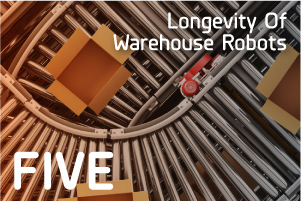 With speed to fulfillment requirements becoming more popular in warehouse automation systems, it's clear to see that downtime needs to stay at a minimum. That means warehouse robots have to be more reliable and durable than ever. A few factors impacting this trend are better power storage, rigorous product design and field testing, easily repeatable manufacturing processes and manageable aftermarket services.
With speed to fulfillment requirements becoming more popular in warehouse automation systems, it's clear to see that downtime needs to stay at a minimum. That means warehouse robots have to be more reliable and durable than ever. A few factors impacting this trend are better power storage, rigorous product design and field testing, easily repeatable manufacturing processes and manageable aftermarket services.
It seems that all of these are obvious ways to ensure reliability, but testing inadequacies can account for a variety of failures in the field. And these don't happen due to lack of trying, but for lack of knowledge of all the factors that can contribute to the failures once the robots are in the field. To ensure you’re in the right position for get ahead of the competition, the best way to overcome these issues are to make strategic relationships with companies where you can outsource some of this work. Those partnerships should be with companies that supplement your individual product expertise with experience in the industry as a whole to ensure that your testing finds issues before they happen in the field.
Even with extraneous amounts of testing, at some point, robots will fail in the field. Another way to ensure your robots last longer is to have a seamless aftermarket service offering so that you can keep your customers going. This too, is a great area for outsourcing, especially if you have companies that are already partnering with for the rest of your product development needs. That way, you can ensure that they have the knowledge to manage your repairs without slowing down your customers.
Trend 6: A greater need for Internet of Things (IoT)
 With supply chains as they are, good warehouse management means having real-time and accurate data about your entire facility. In the past, it may have been okay to know what's in stock or out of stock and not much else, but now your customers need to have big data including predictive analytics and predictive maintenance capabilities to keep their facilities running as smoothly as possible. This all means that IoT sensors need to be abundant and reliable.
With supply chains as they are, good warehouse management means having real-time and accurate data about your entire facility. In the past, it may have been okay to know what's in stock or out of stock and not much else, but now your customers need to have big data including predictive analytics and predictive maintenance capabilities to keep their facilities running as smoothly as possible. This all means that IoT sensors need to be abundant and reliable.
Of all of the trends on our list, this one will be more important this year than ever before, and it will grow more important in every year that follows. Making sensing and connectivity a top priority ensures that you are set on the right path to giving your customers the best possible product. Should this sound like an issue that is insurmountable, there are partners out there ready to make sure your IoT needs are met.
Trend 7: The beginning of mergers and acquisitions in the warehouse automation market
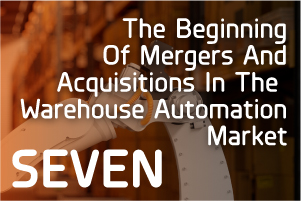 A wide open market means that there are a variety of options for your customers to consider. However, as the market stabilizes, the number of options available is likely to decrease making it the perfect time to set your company up for long term growth and stability. Creating the best product possible and making smart financial decisions are at the top of the list in ensuring success. But making the choice now to look into strategic partnerships to help you properly scale your business should be at the top as well.
A wide open market means that there are a variety of options for your customers to consider. However, as the market stabilizes, the number of options available is likely to decrease making it the perfect time to set your company up for long term growth and stability. Creating the best product possible and making smart financial decisions are at the top of the list in ensuring success. But making the choice now to look into strategic partnerships to help you properly scale your business should be at the top as well.
The first step in building a great partnership is to look into what gaps you have in your current offering – whether it's a supply chain issue, engineering gaps, a manufacturing issue or anywhere in between – make sure your partner has lasting experience in solving the problem. As always, they should also have a keen understanding of how technology in warehouse processes make an impact on the day-to-day needs of your customers.
Get ahead of the trends
With so many warehouse automation industry trends that can get you ahead in your business, it may be hard to focus on all of them at once. That’s okay! You can choose to tackle the ones that you feel will give you the best advantage in serving your customers’ demands. No matter which warehouse automation trends you choose to focus on, having a strategic partner to help you get there can be a key element in your success. And even if you needs go outside of these trends, partners like Plexus are here and ready to help you.
At Plexus, we have decades of experience with bringing highly-complex electromechanical products to market. So as you work through 2022 and beyond, we’re ready to help you navigate the best way forward for success now, and for years to come.